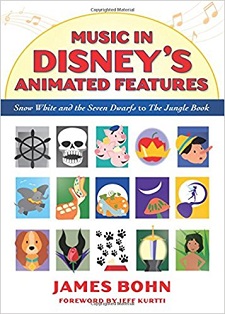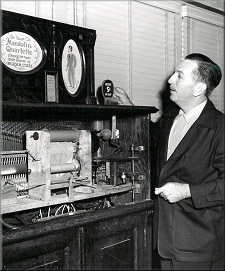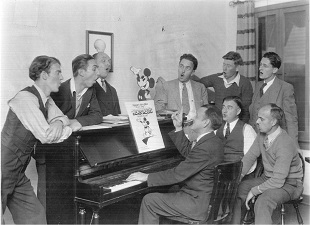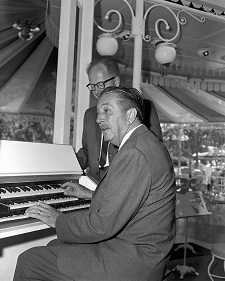 While research on Disney animation has been particularly vivid and productive over the last decade, very little has been done on Disney music. The work of some prominent historians like Ross Care or David Tietyen proved fundamental to the cause, but serious studies are still too rare in regard to the importance of the task.
While research on Disney animation has been particularly vivid and productive over the last decade, very little has been done on Disney music. The work of some prominent historians like Ross Care or David Tietyen proved fundamental to the cause, but serious studies are still too rare in regard to the importance of the task.
James Bohn, from New Bedford, Massachusetts, is a composer and scholar on the faculty at Stonehill College and Bridgewater State University. His music has been performed internationally as well as throughout the United States and has appeared on several recording labels. He is the author of numerous articles and a book on composer Lejaren Hiller.
He’s just published a book, Music In Disney’s Animated Features that constitutes a truly essential contribution to Disney music research.
Particularly well-documented and based on accurate analysis methods, his book investigates how music functions in Disney animated films and identifies several vanguard techniques used in them. In addition, he also presents a history of music in Disney animated films, as well as biographical information on several of the Walt Disney Studios’ seminal composers.
The popularity and critical acclaim of Disney animated features truly is built as much on music as it is on animation. Beginning with Steamboat Willie and continuing through all of the animated features created under Disney’s personal supervision, music was the organizing element of Disney’s animation. Songs establish character, aid in narrative, and fashion the backbone of the Studios’ movies from Snow White And The Seven Dwarfs through The Jungle Book and beyond.
Bohn underscores these points while presenting a detailed history of music in Disney’s animated films. The book includes research done at the Walt Disney Archives as well as materials gathered from numerous other facilities. In his research of the Studios’ notable composers, Bohn includes perspectives from family members, thus lending a personal dimension to his presentation of the magical Studios’ musical history. The volume’s numerous musical examples demonstrate techniques used throughout the Studios’ animated classics.
The book is published by University Press of Mississippi, with a foreword by Jeff Kurtti.
We were pleased to meet the scholar to talk more deeply about his important work.
 AnimatedViews: To you, what makes Disney music so special that a scholar like you wants to research and publish about it?
AnimatedViews: To you, what makes Disney music so special that a scholar like you wants to research and publish about it?
James Bohn: I had my dissertation published, which is a book about Lejaren Hiller, the first composer to write a piece of music using computer. I enjoyed the process of writing and publishing a book, but I decided if I was going to do it again, I would only write about a topic that a lot of people would want to read about.
Once I became engrossed in researching Disney music, it became apparent that Disney is an ideal topic for film scholars. Walt Disney was more involved in the creative output of his Studios than any other studio head in Hollywood. For this reason, he was extremely concerned with documentation. Nearly every story session and sweat box meeting was transcribed, and a large amount of these documents survive. The Disney Music Legacy Library has been digitizing scores, sketches, and other documents relating to the music that has come out of the Studios. It is a researcher’s dream.
This documentation often allows researchers to trace where an idea came from, and how it evolved. Any true fan of film should be interested in Disney films for this reason. No other Hollywood films are as well documented as Disney’s animated features. Most other Hollywood studios throw out anything of interest to scholars. Most notoriously, in 1970 MGM dumped numerous film score manuscripts, sketches, and recordings in a dump near Valencia.
AV: How did you get the idea for this book?
JB: This book started off as a textbook for a class I’ve been teaching at Bridgewater State University for seven years. I was looking for a topic to write a book about, and writing a book for a course is a good motivation to get work done. I thought about three broad questions: what are things that I have some decent knowledge of, what are things that are popular, and what has not been written about sufficiently, and at the center of that Venn diagram was Disney and music.
AV: What is your target audience?
JB: While the book started off as a textbook for my course, I decided to steer the book towards those who have a scholarly interest in film music, and to a lesser extent those who have a scholarly interest in Disney. That being said, I think there’s plenty of material in the book for the average Disney fan.

AV: Why did you choose to focus on animated features?
JB: Disney’s greatest contribution to art and entertainment is their animated features. It is the foundation of their intellectual property, and the creation of Snow White And The Seven Dwarfs was the first step in establishing Disney as a major Hollywood studio.
AV: At the same time, you start your study with Mickey Mouse cartoons and Silly Symphonies. How’s that? How influential were they to the features?
JB: Studying Steamboat Willie through the early Mickeys, and into the Silly Symphonies, one can follow the growing importance of music. Mickey Mouse may have never hit our cultural landscape had it not been for the score to Steamboat Willie. The early Mickeys were, as Ward Kimball put it, musicals. In the Silly Symphonies, music was elevated to become an equal component to character and plot, and indeed with many of the Silly Symphonies, the music was the plot.
The Studios built on the expertise they gained with the Mickeys and Silly Symphonies when they started work on Snow White And The Seven Dwarfs. When you consider the importance of music to the Silly Symphonies, it is hardly surprising that Snow White And The Seven Dwarfs is, essentially, an animated operetta.
AV: At some time, you had envisioned a chapter on both Pinocchio and Fantasia, and finally you took off Fantasia from your book. How’s that?
JB:When I started writing about Fantasia, I decided to not go into detail about the music, as the music was not written for the film, but rather adapted for it. Thus, as I wrote, I found that I was focusing on the Fantasound multichannel music system that the Studios developed for the feature. While Fantasound is interesting, and is an important technical achievement, I decided that it was too far astray from the goal of investigating the role of music in Disney features, so I largely excised Fantasia to keep the focus of the book tighter.

AV: A great part of your musical analysis is based on the Schenkenria method. Why did you choose that one?
JB:Most conventional systems of musical analysis focus on harmony. Melody is a much more important element of music. We recognize a song as being the same even if it is re-harmonized; however, changing the melody while keeping the same harmony is typically not recognizable as the same song. Furthermore, when we leave the theater, we hum or sing the melody of our favorite songs. We typically do not sing through the harmonic progressions.
Schenkerian analysis, with its emphasis of melodic motion and dissonance, seems to be a much better tool to address when asking the question, “why is this song effective?” However, strict Schenkerian analysis comes with a sufficient amount of aesthetic assumptions and cultural baggage, which I feel can inhibit an open-minded approach to investigating music, so I’ve tried to apply Schenkerian analysis very loosely, using it to find what I feel works well, rather than using it to determine to what degree it matches a pre-existing ideal.
AV: Of which analysis are you the proudest?
JB:I enjoyed investigating the three songs I looked at in detail using Schenkerian analysis: “Some Day My Prince Will Come,” “When You Wish Upon A Star,” and “A Dream Is A Wish Your Heart Makes.” All three of these songs involve the idea of dreams or wishes. Dreams and wishes are fundamentally unfulfilled. That is, once a dream or wish is fulfilled it becomes truth, and ceases to be a dream or a wish. I used Schenkerian analysis to compare the idea of melodic resolution (or lack thereof) to the fulfillment of a dream. The presentation of “Some Day My Prince Will Come” and “When You Wish Upon A Star” are not fully resolved melodically speaking until the end of the films they came from (Snow White And The Seven Dwarfs and Pinocchio respectively).

AV: The bios you wrote of the Disney composers of the time are some of the most detailed ever published. Can you tell me about how you worked on them? What was the most difficult one to write?
JB:I owe a great debt to the research of Ross Care and David Tietyen in particular when it comes to the composer biographies. Care had written several articles focusing on the bios of early composers in the Disney Studio. David Tietyen published a book called The Musical World of Walt Disney in 1990. While this book often seems like it is geared for children (it uses large type and has numerous pictures), it has a lot of useful, primary research in it. In fact, I first encountered Tietyen’s book when I was in graduate school, working at a music library. It is the book that first put the idea of taking a scholarly approach to studying the music of Disney in my mind.
After looking at what was readily available in published sources about these composers, I combed through familysearch.org and ancestry.com to find and confirm basic biographical details such as birth date, parentage, descendants, addresses, employment, and the like. I was also able to use death dates to get a hold of obituaries that often filled in gaps. In many case I was able to use information from these sources to find living relatives.
The hardest individual to track down was Bert Lewis. His career as a film composer was confined to working on early shorts for Disney, and later to writing for early MGM shorts. He never wrote for a feature film, and never reached the notoriety that Carl Stalling (who also only wrote for shorts) did. Furthermore, in the early years at the Disney studio, composers were usually not credited on screen. To make matters worse, Bert Lewis has a very common name comprised of two first names. These names are not easy to use as search parameters in familysearch.org or ancestry.com.
I had been in touch with Lewis’ great-granddaughter, and while she had little information to add, I was able to find a partial family tree by using the name of her grandmother, and Bert Lewis as search terms. Once I had other names to search with, I was able to track down Lewis’s information on ancestry.com. It turns out that his official name was Elbert Lewis.
AV: Can you tell me more specifically about the composers’ descendants that you met during that process and how your meetings with them were?
JB:I never met face-to-face with any composer descendants. I mainly corresponded with them through email, Facebook, and telephone. Robert Jason Sherman and Jeffrey Sherman, both sons of Robert Bernard Sherman were able to provide decent feedback and information. However, many of the descendants did not have too much to add, and few of them had any detailed information about careers or musical output. Some of them were able to paint more of a picture of their personality. Linda Britt spoke fondly of visits from her great uncle, Carl Stalling. Theresa Smith Powers and Jerome Smith were able to illuminate the personality of Paul J. Smith, and to provide an image of what it was like to grow up in Hollywood and the Disney Studios.

AV: Can you tell me about your collaboration with the Walt Disney Music Group and your experience/emotions discovering the manuscripts? What did you learn from them?
JB: When I set out to work on this book, I accepted the fact that I may get zero cooperation from the Disney company. I felt I would probably not get access to the Disney Archives at all, and may not even get cooperation in regards to licensing excerpts of music. However, a bit of polite persistence of my behalf definitely paid off. There are those that like to characterize the Walt Disney Company as a large soulless, corporate body. However, it is staffed by people, many of whom are true believers in the artistic vision of Walt Disney and the Studios. Most of the people I encountered in my research have the same dedication to friendliness and helpfulness that you expect of a cast member at Disneyland or World Disney World. I owe a great debt to every single individual who helped me with my research and access to materials. While such access at times could be complicated, there are many who helped me along the way.
Disney has several sources for primary documents. There is the Animation Research Library (which I never accessed, and did not ask to access), the Disney Archives, and the Disney Music Legacy Library (as well as other resources I may not have discovered). The Animation Research Library houses drawings, backgrounds and the like. The Disney Archives tends to house paper documents (contracts, correspondence, meeting transcriptions, and the like). The Disney Music Legacy Library has scores, sketches, and other paper documents related to music. Unlike the Archives, which sometimes put original copies of documents in my hands, the Disney Music Legacy Library is a scanned document library. I was able to search it during a couple of my research visits. You are only able to access documents that have been scanned, but they have a lot of high-quality documents available.
Looking at film scores can be mixed emotional bag. On the negative side it can be frustrating, as most film composers have very messy manuscripts and do not put their name on their work, as their main concern is time. They often have a very short time period to write a large amount of music, so legibility and detailed information are the first casualties of such working conditions. For similar reasons, marginalia is fairly rare. On the other side of the spectrum, it is humbling to be looking at the musical DNA of beloved, classic films and shorts. During my research at the Studios, I was always extremely aware of how privileged I was to have access to these materials, and to adapt a well-known quote of Spider-Man, “with great privilege there must also come great responsibility.”
AV: The book includes a very detailed appendix with all the composers’ credits in each animated feature. Can you tell me about the work on that part?
JB: This part was actually one of the easiest parts. The Studios have cue sheets that contain this information that, among other things, allow them to distribute royalties. The Disney Music Group was kind enough to get me copies of the cue sheets, and I made very few changes to the information they provided.

AV: From your point of view, what are the most interesting discoveries you made along the process of researching and writing this book?
JB: I enjoyed the challenge of doing research on Bert Lewis, Carl Stalling, and many of the early Mickey and Silly Symphony shorts, as it did make me feel as if I setting foot in a largely undiscovered realm. It is probably the closest I will ever get to being Indiana Jones.
AV: Do you plan to go on in other matters of Disney research?
JB: I do have a follow-up volume in the works that I may be ready to talk about in detail – in two or three years!
With very special thanks to James Bohn and Courtney McCreary (University Press of Mississippi).






